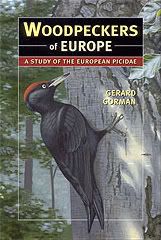
Juvenile male: Both sexes exhibit sexual dimorphism as juveniles and as with adults this involves the extent of red on crown. The first signs of sexual dimorphism appear at about ten days. By the time young are peeping out of the nest-hole they can be visually sexed. Juvenile male very similar to adult male, having most of crown red though this does not extend as far forward as on adult male and is narrower, but almost always more extensive than on females. Red also duller, flecked grey and with dark bases to feathers. Overall black plumage is duller, sooty rather than glossy, often brownish, especially on the wings and tail, sometimes with just a hint of brown. Sometimes grey or white patches in plumage. Throat is paler than adult, being dark grey rather than black. On some birds this is striking, on others hardly noticeable. Iris is often bluish-grey not white as adult. Bill is cleaner with grey tip rather than all greyish-white as most adults and culmen ridge is grey not black. Legs and feet are lighter than on adult, being bluish-grey. Recently fledged juveniles have an odd wedge-shaped tail due to most of two tail feathers being initially shorter than on adults. Juvenile female: As juvenile male but shows adult female trait of red only on hind-crown. But this is often minimal being just a few feathers with dark bases and red tips, and sometimes almost completely absent. It is difficult to judge whether juveniles lacking red are males or females, though a fair guess is that young lacking red will be females rather than males. There can be some variation in the amount of red that juveniles show on the crown within broods as well as between broods. The photo above shows a juvenile male, recently fledged. Crisan, Danube Delta, Romania (Daniel Petrescu). Note the all red crown denoting a male even at this age. Also the brown plumage, especially on the wings, and the short tail feathers.





No comments:
Post a Comment